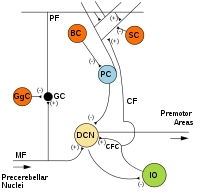
Photo from wikipedia
Cerebellar participation in timing and sensory-motor sequences has been supported by several experimental and clinical studies. A relevant role of the cerebellum in timing of conditioned responses in the range… Click to show full abstract
Cerebellar participation in timing and sensory-motor sequences has been supported by several experimental and clinical studies. A relevant role of the cerebellum in timing of conditioned responses in the range of milliseconds has been demonstrated, but less is known regarding the role of the cerebellum in supra-second timing of operant responses. A dissociated role of the cerebellum and striatum in timing in the millisecond and second range had been reported, respectively. The climbing fibre-Purkinje cell synapse is crucial in timing models; thus, the aberrant connection between these cellular elements is a suitable model for evaluating the contribution of the cerebellum in timing in the supra-second range. The aberrant connection between climbing fibres and Purkinje cells was induced by administration of the antagonist of NMDA receptors MK-801 to Sprague–Dawley rats at postnatal days 7–14. The timing of an operant response with two fixed intervals (5 and 8 s) and egocentric sequential learning was evaluated in 60-day-old adult rats. The aberrant connections caused a reduced accuracy in the timing of the instrumental response that was more evident in the 8-s interval and a reduced number of successive correct responses (responses emitted in the correct second without any other response between them) in the 8-s interval. In addition, an inability to incorporate new information in a sequence previously learned in egocentric-based sequence learning was apparent in rats with aberrant CF–PC synapses. These results support a relevant role for the cerebellum in the fine-tuning of the timing of operant responses in the supra-second range.
Journal Title: Experimental Brain Research
Year Published: 2017
Link to full text (if available)
Share on Social Media: Sign Up to like & get
recommendations!